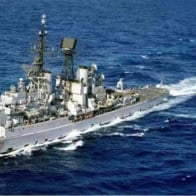Howard Gibson
Senior Airman
Between the mid-fifteenth century and the mid-twentieth centuries, naval warfare was dominated by gunboats. In combat between gunboats, big gunsboats defeat small gunboats. The big gunboats have some combination of bigger guns, more guns, and more capacity to take punishment. Hydrodynamically, big ships are faster than small ships, although, big battleships have generally sacrificed speed for protection. In a war, it makes sense for an admiral to board his biggest, most powerful gunboat, and put is flag up, making it his flagship. The largest and most powerful gunboats are classifed as "capital ships".
This has affected our thinking about warships. We imagine ancient galleys as massive, impressive ships. Ancient galleys, at least as used in Greece, used rams as their primary weapons. The Romans were more into boarding. Ancient galleys ought not be imagined as modern capital ships. Modern fighter aircraft are a much better analogue. A ram equipped galley needs to be fast, it need high acceleration and deceleration, and it must do fast turns. A small galley is harder to hit than a big galley. You need a small, lightweight ship, packed with highly trained, muscle-bound rowers. Galley slaves were invented by the Spanish during the sixteenth century AD, and galleys quickly becamse obsolete.
During the Persian War, the Peloponnesian War, and the Punic Wars, city states built hundreds of galleys each. When storms broke out and caught galley fleets at sea, hundreds generally were wrecked. It is a very safe bet that these galleys were not Nimitz class aircraft carriers. They were small, lightly built, probably open boats. At the Battle of Salamis, Xerxes commanded from a throne located on-shore. Themistocles followed the Greco-Macedonian tradition of throwing himself into the middle of the battle.
This brings us to aircraft carriers. At the start of WWII in 1939, the Royal Navy had seven carriers, five of which would be sunk during the war. In 1941, the US Navy had eight carriers, five of which were sunk. Of ten sunken carriers, the Japanese got six. U-boats got three, and the Scharnhorst and Gneisnau got one. I did not bother to look up the Japanese. I assume that all of theirs got sunk.
Carriers have replaced battleships as capital ships. The big American carriers in particular are described as "cities at sea", with Nimitz carriers displacing over 100,000 long tons. American carrier groups seem to have one carrier only. If the Americans go up against a powerful enemy, how many of these carriers can they afford to lose?
Wouldn't it be wiser to treat carriers as consumables, make them as small as possible, and make as many as possible? Any thoughts?
This has affected our thinking about warships. We imagine ancient galleys as massive, impressive ships. Ancient galleys, at least as used in Greece, used rams as their primary weapons. The Romans were more into boarding. Ancient galleys ought not be imagined as modern capital ships. Modern fighter aircraft are a much better analogue. A ram equipped galley needs to be fast, it need high acceleration and deceleration, and it must do fast turns. A small galley is harder to hit than a big galley. You need a small, lightweight ship, packed with highly trained, muscle-bound rowers. Galley slaves were invented by the Spanish during the sixteenth century AD, and galleys quickly becamse obsolete.
During the Persian War, the Peloponnesian War, and the Punic Wars, city states built hundreds of galleys each. When storms broke out and caught galley fleets at sea, hundreds generally were wrecked. It is a very safe bet that these galleys were not Nimitz class aircraft carriers. They were small, lightly built, probably open boats. At the Battle of Salamis, Xerxes commanded from a throne located on-shore. Themistocles followed the Greco-Macedonian tradition of throwing himself into the middle of the battle.
This brings us to aircraft carriers. At the start of WWII in 1939, the Royal Navy had seven carriers, five of which would be sunk during the war. In 1941, the US Navy had eight carriers, five of which were sunk. Of ten sunken carriers, the Japanese got six. U-boats got three, and the Scharnhorst and Gneisnau got one. I did not bother to look up the Japanese. I assume that all of theirs got sunk.
Carriers have replaced battleships as capital ships. The big American carriers in particular are described as "cities at sea", with Nimitz carriers displacing over 100,000 long tons. American carrier groups seem to have one carrier only. If the Americans go up against a powerful enemy, how many of these carriers can they afford to lose?
Wouldn't it be wiser to treat carriers as consumables, make them as small as possible, and make as many as possible? Any thoughts?


